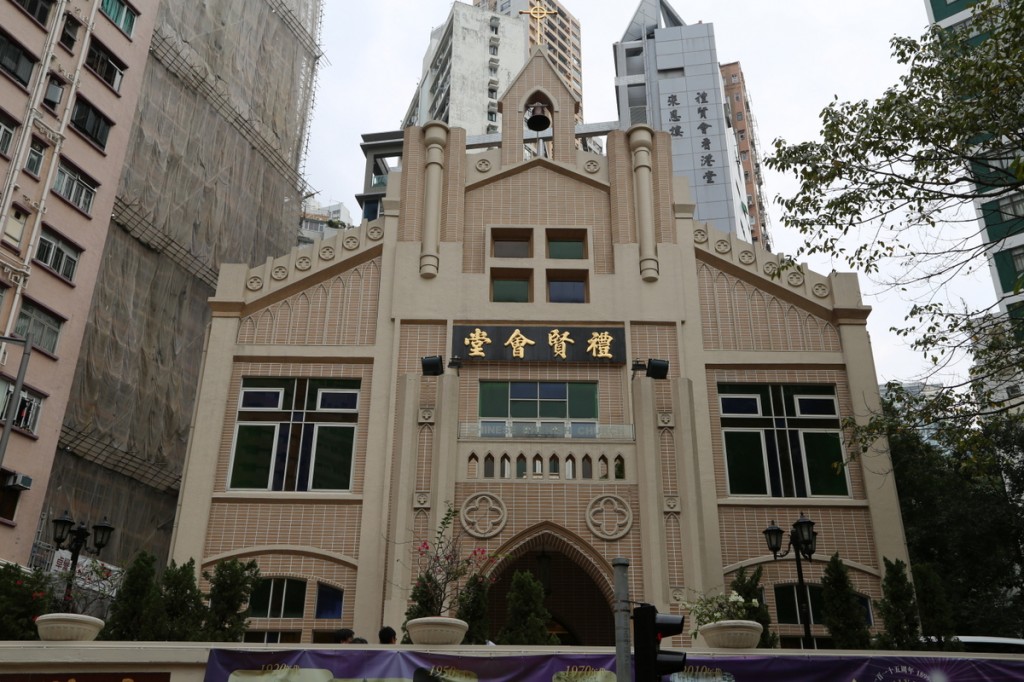第三站/ 中華基督教禮賢會香港堂
Third Station/ Chinese Rhenish Church Hong Kong
地址/ 般咸道86號
Address/ 86A Bonham Road
德國巴勉差會於1847年來華宣教,初時在內地傳教,本來未有計劃在香港建堂。教會起源自德國的萊茵河區,故以東莞話音譯「萊茵」命名為「禮賢會」。「禮賢會香港堂」於1899年成立,教堂於1914年(十五年後)在西營盤現址建成,屬於哥德式及羅馬式混合的折衷主義建築風格。每次祟拜前,屋頂的銅鐘都會響起,以通知附近的信徒。
教會於1910年成立禮賢學校,先後座落第二街和教堂地下副堂,並因應當時適齡女孩的失學問題,於1919年註冊為「香港禮賢會女校」,及後於1960年改名為「香港禮賢會學校」招收男女生,直至1970年因小學人數減少而停辦。禮賢會亦於1936年設立幼稚園部,在2007年遷入重建落成的「來恩樓」至今。
禮賢會於世界大戰期間經歷不同的際遇,背後與其德國背景息息相關:一次大戰後,港府規定教會及其產業須轉歸英國牧師處理至1927年,及後開始由華人牧師及會衆自理財政權責會務;二戰時期,可能日德是盟軍的關係,教會免遭日軍滋擾,容許繼續崇拜聚會,並自辦合作社購辦糧食,照顧米食不足的會友。
The German Barmen Mission came to China to spread the Gospel in 1847. At the beginning, it evangelised in Mainland China and had yet plan to set foot in Hong Kong. Since the missionary society originated from the Rhine in Germany, it later changed its name to ‘Rhenish Missionary Society’. In 1899, the Chinese Rhenish Church Hong Kong was established, and in 1914, fifteen years later, its church was built on its present site in Sai Ying Pun. The style of the architecture belongs to Eclecticism, displaying a mix of Gothic and Romanesque architectural styles. Before each worship, the copper bell on the roof is struck to inform followers living nearby.
In 1910, the Chinese Rhenish Church founded the Rhenish Mission School on Second Street; it was later moved into the parish hall on the ground floor of the Chinese Rhenish Church building. In order to address the problem of out-of-school girls at that time, the school was registered as ‘Hong Kong Rhenish Mission Girls’ School’ in 1919. In 1960, the school changed its name to the Hong Kong Rhenish Mission School which allowed both male and female students until its closure in 1970. In 1936, the Chinese Rhenish Church established a kindergarten, which has moved to the Emmanuel House rebuilt in 2007.
The Rhenish Church was subject to different circumstances during the two world wars because of its German background. After World War I, the Hong Kong colonial government instructed that missionary societies and their properties were to be taken over and run by British pastors until 1927. Subsequently, Chinese priests and followers started to manage the finances and administration of their churches. During the Japanese occupation of Hong Kong in WWII, the church was not disturbed by the Japanese army and was able to continue its services and gatherings. This was possibly because Germany and Japan were allies. The church was also allowed to initiate a co-operative society, and bought food to distribute to church members who struggled to make their ends meet.
連結 Links/
上一站/ 英皇書院 Previous Station/King’s College
下一站/ 香港大學 Next Station/ The University of Hong Kong
西營盤歷史文化徑/ 教會及學校發展 Sai Ying Pun Heritage Trail/ The Development of Missionary Societies and Schools




